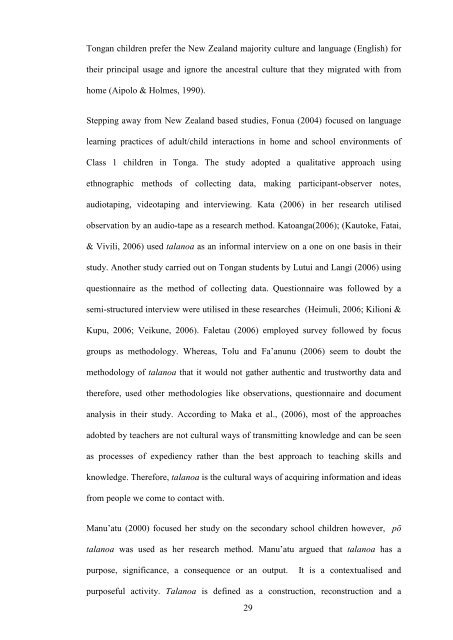Talanoa - Scholarly Commons Home
Talanoa - Scholarly Commons Home
Talanoa - Scholarly Commons Home
Create successful ePaper yourself
Turn your PDF publications into a flip-book with our unique Google optimized e-Paper software.
Tongan children prefer the New Zealand majority culture and language (English) for<br />
their principal usage and ignore the ancestral culture that they migrated with from<br />
home (Aipolo & Holmes, 1990).<br />
Stepping away from New Zealand based studies, Fonua (2004) focused on language<br />
learning practices of adult/child interactions in home and school environments of<br />
Class 1 children in Tonga. The study adopted a qualitative approach using<br />
ethnographic methods of collecting data, making participant-observer notes,<br />
audiotaping, videotaping and interviewing. Kata (2006) in her research utilised<br />
observation by an audio-tape as a research method. Katoanga(2006); (Kautoke, Fatai,<br />
& Vivili, 2006) used talanoa as an informal interview on a one on one basis in their<br />
study. Another study carried out on Tongan students by Lutui and Langi (2006) using<br />
questionnaire as the method of collecting data. Questionnaire was followed by a<br />
semi-structured interview were utilised in these researches (Heimuli, 2006; Kilioni &<br />
Kupu, 2006; Veikune, 2006). Faletau (2006) employed survey followed by focus<br />
groups as methodology. Whereas, Tolu and Fa’anunu (2006) seem to doubt the<br />
methodology of talanoa that it would not gather authentic and trustworthy data and<br />
therefore, used other methodologies like observations, questionnaire and document<br />
analysis in their study. According to Maka et al., (2006), most of the approaches<br />
adobted by teachers are not cultural ways of transmitting knowledge and can be seen<br />
as processes of expediency rather than the best approach to teaching skills and<br />
knowledge. Therefore, talanoa is the cultural ways of acquiring information and ideas<br />
from people we come to contact with.<br />
Manu’atu (2000) focused her study on the secondary school children however, pō<br />
talanoa was used as her research method. Manu’atu argued that talanoa has a<br />
purpose, significance, a consequence or an output. It is a contextualised and<br />
purposeful activity. <strong>Talanoa</strong> is defined as a construction, reconstruction and a<br />
29

















